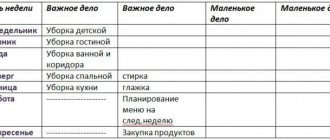Why is your daily routine so important?
Why is the daily routine important? The baby grows very quickly and develops rapidly; every month he develops new skills, interests, abilities and preferences. And so that a child can explore the world actively and harmoniously, he needs to be helped in this. And this is precisely why a daily routine is needed.
If the baby performs certain actions according to the schedule, he will feel protected. The regime is a kind of ritual lasting the whole day. The procedures are performed in a certain sequence and at approximately the same time, which forms habits and once again proves that everything is in order, there are no drastic changes or unfamiliar situations.
By observing the daily routine, the child gradually learns discipline and becomes organized. This will be very useful when the baby starts attending kindergarten, where all actions are carried out strictly according to the schedule. It will be easier for the child to wake up and fall asleep at the same time, and eat food at certain intervals.
But the regime is also very useful for parents. If a mother knows what her son or daughter will do and when, then she is calm, organized and not in a state of stress or misunderstanding due to ignorance and inconstancy. Parents have free time, because if you build a routine taking into account the needs of the whole family, you can find time intervals for your own affairs.
Why do primary school students need a daily routine?
Why do primary school students need a daily routine?
You should not neglect the organization of the working day, especially for children, starting from school years. Compliance with a certain routine leads to the fact that the child’s energy is not wasted, it is distributed in doses and is enough for all types of activities. At the same time, the vitality of the body increases, fatigue is minimized and strength is quickly restored.
Creating the correct daily routine depends on the individual characteristics of the student: health status and characteristics of a particular age. The schedule should include the following main elements in a certain order:
- School activities and homework;
- Time to rest;
- Nutrition;
- Dream.
As the child adheres to the daily routine, he will develop the habit of doing everything at a certain time, the body will turn on the internal clock and subsequently all actions will become a habit.
What changes in a child’s daily routine at 1 year old?
The daily routine of a baby at the age of one year is not very different from the routine at 11 months, as well as at 1 year and 1 month. A one-year-old baby experiences the same needs for physical activity, emotional and intellectual development, nutrition and sleep. Nothing fundamentally new appears in the daily schedule.
The only thing that can undergo changes is sleep. It can be either twice or once per year. If the baby wakes up early and is tired after active morning activities, he simply needs rest to restore strength and “reboot” the brain. If the baby doesn’t wake up very early, and his nervous system is strong enough, then he can easily sleep once: a single sleep will be enough to rest, replenish energy reserves and assimilate the information received during the first half of the day.
How do you know what kind of sleep is right for your baby? Take into account his habits and needs, watch him. If by lunchtime the baby begins to be capricious and rub his eyes, and also looks lethargic and tired, then it will probably be useful for him to rest in the morning. If the child is calmly awake and does not show signs of fatigue, then one afternoon nap will be enough, especially if the son or daughter goes to bed at night not very late.
Schoolchild's daily routine on weekends
If a daily routine has been introduced in the family, then it must be carried out daily; there cannot be weekends or holidays for it. Naturally, on Saturday and Sunday it will be adjusted without taking into account going to school and doing homework. But it is not recommended to exclude the main points from it. You can move your wake-up time up one hour later, replace your school time with a weekly family activity, or replace your homework hours with going to the movies with friends. But all other points must remain unchanged.
Mandatory components of the daily routine of a one-year-old baby
What should a 12 month old child absolutely do during the day? Its schedule includes the following components:
- Dream. Can be single or double.
- Meals. The number of feedings is six times.
- Walks in the open air.
- Understanding the surrounding world and various phenomena through educational activities and games.
- Physical activity. These are active games that allow you to splash out energy and emotions.
- Hygiene procedures: washing, brushing teeth, taking a bath.
Wunderlist 2
Wunderlist is suitable for those users who own devices from different platforms. The app allows you to create lists, attach reminders and notes to them, turn on notifications, and add subcategories for tasks. Wunderlist supports cloud synchronization. As for cross-platform, you simply download the application to your PC, selecting the version based on your operating system, and edit all lists from your computer. To synchronize, you will need Facebook account. download Wunderlist 2 here.
Android, task scheduler, apps, Android apps
5 apps to create a daily routine on your Android device: rated 80 out of 80 based on 80 ratings. There are 80 reviews in total.
Daily routine: table by hour
The baby's daily routine per year will include all the activities listed above. The sample schedule table below clearly shows what a schedule might look like with two naps during the day:
| Time intervals | Actions and procedures |
| 6 a.m | Waking up after a night's sleep. Morning hygiene procedures (washing), as well as changing clothes. |
| From 6:15 to 6:30 | First feeding: either breast milk or formula. |
| From 6:30 to 7:30 | Games in quiet mode. |
| From 7:30 to 8:30 | Gymnastics, massage, communication. |
| From 8:30 to 9 | Breakfast. |
| From 9 to 11 o'clock | First morning dream. It can be combined with a stroller walk in the fresh air. |
| From 11 a.m. to 1 p.m. | Various games or educational activities with the parent. |
| From 13:00 to 13:30 | Full lunch. |
| From 13:30 to 15 hours | Fun joint games with mom and other family members, physical activity. |
| From 15:00 to 16:30 | The second walk, during which you should play actively, look at different objects on the street. |
| From 16:30 to 16:45 | Afternoon snack. |
| From 16:45 to 18 hours | Second dream. |
| From 18:00 to 18:30 | Waking up, changing clothes, communicating. |
| From 18:30 to 19 hours | Dinner. |
| From 19:00 to 20:30 | Calm, inactive entertainment. For example, communication, reading books, looking at pictures. |
| From 20:30 to 21 | Bathing before bedtime, changing clothes, relaxing massage, brushing teeth and other hygiene procedures, as well as bedtime ritual. |
| From 21:00 to 21:30 | Last feeding at night. |
| From 21:30 to 6 o'clock | Night deep sleep. |
And this table shows a sample regime for a baby who sleeps once a day:
| Time intervals | Actions and procedures |
| 6 a.m | Waking up after a night's sleep. Morning hygiene procedures (washing), as well as changing clothes. |
| From 6:15 to 6:30 | First feeding: either breast milk or formula. |
| From 6:30 to 7:30 | Games in quiet mode, development. |
| From 7:30 to 8:30 | Gymnastics, massage, communication. |
| From 8:30 to 9 | Breakfast. |
| From 9 o'clock to 11 o'clock | Games at home. |
| From 11 a.m. to 12:30 p.m. | Getting dressed, walking in the fresh air. |
| From 12:30 to 13 o'clock | Changing clothes, communicating. |
| From 13:00 to 13:30 | Full lunch. |
| From 13:30 to 16:30 | Daytime long single sleep. |
| From 16:30 to 17 hours | Changing clothes, communicating with a parent. |
| From 17:00 to 17:15 | Afternoon snack. |
| From 17:15 to 17:30 | Dressing, socializing. |
| From 17:30 to 19 hours | Walk outside. |
| From 19:00 to 19:15 | Changing clothes. |
| From 19:15 to 19:45 | Dinner. |
| From 19:45 to 20:30 | Quiet entertainment: playing with toys, looking at pictures, reading books, talking. |
| From 20:30 to 21 | Bathing before bedtime, changing clothes, relaxing massage, brushing teeth and other hygiene procedures, as well as bedtime ritual. |
| From 21:00 to 21:30 | Last feeding at night. |
| From 21:30 to 6 o'clock | Night deep sleep. |
The tables indicate approximate hours. All children are different: some wake up earlier, others later. It is worth starting from the time of natural independent awakening when planning your daily routine. Follow the intervals shown above.
Organizing a daily schedule for the student
A typical school day looks like this:
- Rise – 07:00.
- Exercise, personal hygiene, bed making – 07:00–07:20.
- Breakfast – 07:20–07:40.
- Travel to school – 07:50–08:20 (this parameter depends on how far the child lives from school and how he will get there).
- Lessons – 08:30–12:00 (refer to the schedule).
- Second breakfast – 10:30–10:40.
- The way home, which is both a walk and a time to socialize with peers, is 12:00–12:30.
- Lunch – 12:30–13:00.
- Rest (games, hobbies) – 13:00–14:00.
- Doing homework – 14:00–16:00.
- Afternoon tea – 16:00–16:10.
- Walk, games with peers – 16:10–17:30.
- Free time: communication with family, hobbies, watching TV, reading, playing on a computer or mobile device, helping around the house - 17:30–19:00.
- Dinner – 19:00–19:20.
- Free time – 19:20–20:00.
- Getting ready for bed, personal hygiene – 20:00–20:20.
- Sleep – 20:30–7:00.
I would like to touch upon such a moment as games on computers or mobile devices. Always be interested in what your child is playing and how much time he devotes to it. It is necessary to regularly take a break from the screen by doing special exercises for the eyes. And do not allow children to play after dinner, because as a result, sleep is disturbed, the child sleeps restlessly and does not fully rest. It’s better to let him devote his free time between dinner and getting ready for bed to reading, quiet games, and communicating with his family.
This option is suitable for children who study in the first shift. But what about those who study for the second time?
This may be useful: GTO registration for schoolchildren on the official website.
Sleep Features
Sleep plays a very important role, so it should be given special attention. And there are several most important points. Firstly, the duration of a baby's sleep per year is a total of about 13-14 hours. The baby sleeps for about 9-10 hours at night, and the rest of the time during the day.
Secondly, attention should be paid to styling. Some babies fall asleep on their own, and these babies can simply be placed in their crib. Others need help to relax, adjust to rest mode, and process the information received during the day. If your son or daughter does not fall asleep on his own, think over and perform a certain ritual - a sequence of actions. For example, this could be eating, changing clothes, reading a book or singing a lullaby, moving to a sleeping place, hugging or holding hands.
Thirdly, it is worth remembering that not all children sleep continuously throughout the night without waking up. Some people wake up once, while others get up several times. But it is important to show that you need to continue sleeping: do not turn on the light, do not entertain the child. If crying is intense, offer water, breast or formula.
Can a night owl also become a morning person?
In psychology, we often come across the definition of some people as “night owls.” "Owls" are most active in the evening and at night, and getting up early is very difficult for them. Other people are early risers. On the contrary, they get up early, and by the evening their energy supply runs out.
This classification is very conditional. The experience of athletes, politicians and entrepreneurs who travel a lot around the world suggests that the type of activity can be changed quite quickly. To do this, you need to apply the right strategy:
- After the flight, leave 2-3 days for adaptation, planning as few things as possible;
- a few days before the trip, switch to easily digestible foods and abstain from alcohol;
- if possible, use the morning flight to fly west and the evening flight to the west;
- 2-3 days before departure, start living according to the time of the new time zone;
- if you are flying to the west, then sleep should be shifted a few hours later, and when traveling to the east, you should go to bed and get up earlier.
If changes do not occur often, then the body itself rebuilds its operating mode. For example, a schoolboy studies in the first shift. He easily wakes up and gets into work in the first half of the day. And after enrolling in evening studies at a university, within one and a half to two months he can easily cope with academic workloads after 18.00.
For most people, the following periods of activity of various body systems are correct:
05:00-06:00.
Light sleep during this period is due to the fact that the sugar content in the blood increases and metabolism accelerates.
07:00-09:00.
It's time for physical exercise and breakfast. The digestive system is active, food absorption is easy and fast.
09:00-10:00.
The food from breakfast is digested. Light carbohydrates from it help to quickly solve attention problems.
10:00-12:00.
During this period, mental activity is maximum and performance is high.
12:00-14:00.
Dinner time. Performance decreases.
14:00-16:00.
It is better to devote this period to rest and leisurely digestion of food.
16:00-18:00.
The second period of high mental activity and performance.
18:00-20:00.
At the beginning of this period, you need to have dinner so that the food has time to be absorbed by the body before the morning. An hour to an hour and a half after dinner is good to take a walk.
20:00-21:00.
Time for sports, socializing and cultural events.
21:00-22:00.
A period of high mental performance.
22:00.
The body goes into rest mode.
23:00-01:00.
The metabolism slows down greatly, the pulse is rare, the body is completely relaxed.
02:00-03:00.
During this period, insomnia is most harmful. The body must rest.
Nutritional Features
During the baby's year, it is still recommended to breastfeed or use an adapted formula. But breast milk or formula is no longer the main food. It is also important to include other foods in the diet that ensure that the child’s body receives the necessary nutrients. At one year old, the baby eats much less often than in the first six months of life. He eats 6 times (with milk feedings). Portion sizes also increase to take into account the needs of a growing body.
A one-year-old child has about 8-10 teeth, so chewing skills can be developed. To do this, offer not only pureed food, but also soft food in small pieces (1-1.5 cm in size). These can be fresh or thermally processed non-solid vegetables and fruits. You can also give baby cookies and bread.
What foods should be included in the diet
The baby's diet per year should be varied, complete and balanced. The diet includes the following products:
- Breast milk or formula. The daily volume is no longer large; you can leave only two feedings: the morning after waking up, and the evening before bedtime. But milk or formula can be offered for an afternoon snack.
- Cereals: wheat, corn, buckwheat, rice, barley. Cereals are offered in the form of porridges, baked goods and pasta.
- Eggs: either chicken or quail. First, the yolk is given, then the white is gradually introduced.
- Meat: beef, rabbit, veal.
- By-products (beef): liver, tongue, heart.
- Poultry: turkey, chicken (if there is no allergy).
- Vegetables, melons, root vegetables: carrots, potatoes, different varieties of cabbage, zucchini, beets, pumpkin.
- Fruits and berries: pears, plums, blueberries, apricots, apples, peaches, raspberries. They are given fresh, in puree, compotes. Citrus fruits are not offered per year. Red berries and fruits are excluded in the presence of allergic reactions.
- Fermented milk products: yoghurt, cottage cheese, hard cheese (lightly salted).
- Cow's milk.
Menu
Let's look at the daily menu for a one-year-old baby in the table:
| Eating | Food |
| First appointment | Formula or breast milk. |
| Breakfast | Dairy-free or milk porridge (can be with butter), half an egg, some fruit if desired (can be added to the porridge), juice. |
| Dinner | Vegetable dish (soup, puree, stew), vegetable oil, meat or fish (in the form of steamed meatballs or cutlets, soufflé), a piece of bread, juice. |
| Afternoon snack | Cottage cheese, fruit, children's cookies, kefir/milk. |
| Dinner | A vegetable dish (can be with pasta), a little vegetable oil, fish or meat, juice or compote. |
| Last meal | Breast milk or formula. |
Norms, portion sizes and volumes of food consumption
How much should a one year old child eat per day? To determine the norm, you can divide the baby’s body weight by 8 or 9. On average, a baby weighing 10-11 kilograms will eat from 1100 to 1300 grams per day.
Now let’s look at the consumption standards for individual products:
- Breast milk or formula – up to 300-400 ml.
- Porridge – 200 g.
- Vegetable puree – 200 g.
- Fruit puree – 110-125 g.
- Fruit children's juice - about 100 ml.
- Fermented milk products – up to 200 g.
- Meat – 70-80 g.
- Fish - about 60-70 g.
- Cow's milk - no more than 150-200 ml.
- Cookies, children's crackers - 10-20 grams.
- Wheat bread – 10-15 grams.
- Vegetable oil – 5 g (teaspoon).
- Butter – 5 g.
- Egg – 50-60 g (half a chicken egg).
Get busy with scheduling and planning.
How to make a daily schedule? To be as productive as possible without harming your health, you need to plan your day wisely. In general, planning is an art. In this art, it is important to distribute priorities and take into account the human factor - laziness, poor health, inability to concentrate.
For better concentration and to avoid forgetting anything, use apps for effective planning and time management. Also write down in your schedule the place where you will do something. and conditions so that nothing distracts you if you have difficulty concentrating. Partial example of a daily routine:
13-00 lunch in the office, rest
13-20 - 14-00 - work in a cafe on a list of tasks. Take headphones and use the Forest program to concentrate.
Making plans and prioritizing is actually a very expensive process. Therefore, to create a competent schedule for the day, divide it into three stages:
- Summarize the day in the evening;
- Before going to bed, write down everything you would like to do tomorrow;
- Sutra, make a to-do list from this.
Good planning is the key to success in many areas. It’s better if you go shopping with a list, because this reduces the risk of buying unnecessary things and forgetting what you need. It is important that the business starts with a business plan that will help you understand where to move next.
Advertising will be placed here
Skills of a one-year-old child
What should a 1 year old baby be able to do?
- Stand confidently, walk (optional), crawl, sit.
- Rise to your feet from any position, squat and stand.
- React to relatives.
- Respond to name.
- Confidently hold and grasp objects.
- Pronounce syllables or simple monosyllabic words.
- Try to climb or climb onto low objects, or get off them.
- With the help of adults, assemble simple pyramids.
- Point to objects.
- Build small towers.
- Roll toys on wheels.
- Roll the ball.
- Open and close furniture doors.
- Imitate the actions performed by adults: shake or shake your head, clap, comb your hair, blow on something.
- Show emotions and feelings: smile, cry, hug, laugh, get angry, cuddle with mom.
- React to music: try to sing along, move.
- Imitate animals.
- Fulfill simple requests: give, take, bring, put.
- Play “okay”, wave your hand, primitively play “peek-a-boo”.
This is not a complete list of all skills. But development occurs individually, so the baby does not have to be able to do everything on the list. Some skills can be mastered gradually and a little later.
How I plan my week
I'll tell you how I usually do this to make it clearer.
First, I make a mind map of areas of life (“brainstorming”) in a program using a tablet. I add key tasks, events, and goals for the week there.
Then, based on the map, I directly plan things in a paper weekly planner , where the entire week is visible on the spread. This is what allows you to balance the load, since you can immediately see the number of tasks for each day.
If there are already a lot of plans for a certain day, I won’t even add anything else to it. Thanks to this, you don’t have to postpone unfinished tasks to one of the following days.
Also, when planning a week, I take the monthly plan as a basis. I talked about this in detail in one of the blog articles.
How to develop a baby harmoniously and comprehensively
In order for the baby to develop comprehensively and harmoniously, act in different directions. The following activities are useful:
- reading picture books;
- collecting simple puzzles;
- building pyramids;
- building towers from cubes;
- showing various objects and phenomena;
- use of sorters;
- games on educational mats or in play centers;
- use of the first children's construction sets with safe parts;
- communication;
- modeling from salt dough;
- painting with safe finger paints;
- listening to music, dancing.
Now about motivation and well-being
A popular problem with the cult of overperformance is emotional burnout and physical exhaustion. In pursuit of closed tasks, people sacrifice rest, leisure, communication with friends and their health. When creating a todo list, many people try to fill every hour with something useful. And they feel guilty when they rest or “let go” (having fun and having fun just like that). Does this lifestyle bring you happiness? Usually, no. Because this is our essence: if we accelerate, we cannot stop. And sometimes you just need to master the simple art of not being unhappy. Joy in the little things and self-acceptance on all levels: with laziness, partly irresponsibility and unwillingness to meet someone's expectations.
Is this your desire?
When we lose enthusiasm, we end up looking for information on how to increase productivity and add even more motivation. We exhaust ourselves even more when the internal block is already triggered - loss of enthusiasm. This is an internal fuse. What exactly is motivation? This is the desire to do something for various reasons: a vision of a long-term goal, pleasure, satisfaction of a need, etc. That is, no desire - no motivation. Seems obvious, doesn't it? Why then, in the absence of the desire to do anything, do we try to artificially evoke it in ourselves? Ask yourself if this is your desire. Or is it dictated from outside? Is this fear or a tribute to fashion?
Think about it: will you be happy if you satisfy a desire that is not yours? The answer is yours. But what you will definitely get is nervous and physical exhaustion. Because inducing motivation in yourself by force is a very unnatural process.
Gymnastics
Already at one year old, you can accustom your baby to regular morning exercises. Gymnastics may include the following simple exercises:
- Squats with handle support.
- Walking in place or along a line.
- Retrieving toys from heights.
- Crawling on all fours.
- Hand raises.
- Rollovers from stomach to back and from back to stomach.
- Simple exercises on a fitball with the help of a parent.
- Take deep breaths and exhales.
The exercises must be demonstrated by the parent conducting the gymnastics. The baby will watch, repeat and remember the movements.
Hygiene procedures
Hygiene procedures for a one-year-old child include:
- Washing. You should wash your baby in the morning after waking up. Use warm water, do not let it get into your eyes. Wet your hand generously and gently rub it over your baby's face. It is important that the procedure is comfortable, otherwise the child will be afraid of washing and will flatly refuse it.
- Brushing your teeth. This procedure should begin after the first teeth appear. Use a soft silicone brush (there are options that can be placed on the parent’s finger) and a special children’s paste. Cleanings are carried out in the morning and evening.
- Hand washing. Hands should be washed after coming from outside using soap. Before eating, washing with running water is sufficient.
- Bathing. Bathe your baby in a baby bath or in an adult bathtub in a special seat. Maintain the optimal water temperature - about 37-37.5 degrees. Offer water games with rubber toys.
Todo.txt Touch, $2.00
Todo.txt Touch is one of the best solutions for Dropbox when combined with Text Edit or Notepad . The application allows you to synchronize todo.txt files of your Android device with a cloud service. The files themselves can be modified using any text editor, and separated tasks from each other using line breaks that are displayed in Windows . With Todo.txt Touch you can create sections and categorize them by project. You can also use the app to write down phone numbers if you don't want to clutter your contact list. download Todo.txt Touch here.
Recommendations for parents
Finally, recommendations for parents for competent and harmonious organization of the daily routine:
- When creating a routine, it is important to take into account the individual characteristics of the child: needs, already established habits, temperament and biological clock. So, if the baby is used to waking up at 7 am, you should not try to move the rise by a couple of hours. If the baby is an owl, then, on the contrary, do not try to wake him up very early. An active and temperamental child needs to be offered more active games to release emotions and energy. A calm child is more interested in measured activities.
- If you are just trying to introduce a daily routine, you should not do it abruptly. It is unlikely that you will succeed, but you will experience stress with your child. Take it gradually and be patient. Establishing a routine can take anywhere from a few weeks to a few months. It all depends on the baby and your mood. But you shouldn’t retreat, because a daily routine is needed in any case.
- When drawing up a routine, it is worth taking into account the gender of the child. Although there is no big difference, there are still some nuances. Thus, girls’ daily routine may include more educational and calm games, because female children are usually calmer and more diligent. And boys’ daily routine should include more physical activity. Male babies, as a rule, are more active and temperamental than girls, so they need to splash out their energy. But developmental activities must also be present, they just need to be alternated with activity.
- It's useful to talk through what you're doing.
- Don't try to compare your baby with other children. All are very different and have individual characteristics.
- Sometimes the baby can get out of routine, and this is normal. But after such departures, return to your usual routine.
- Don't demand too much and show love.
If you create a suitable daily routine and ensure compliance with it, you will be able to establish a regular routine. This will make the baby calm and disciplined, provide comfort to the whole family and free up time for parents.
Daily routine of schoolchildren studying in the second shift
Daily routine of schoolchildren studying in the second shift
There is a very inconvenient form of training for everyone - in the second shift. But this is an objective reason that schools cannot yet refuse due to workload. Accordingly, the daily routine of schoolchildren studying in the second shift will be different. It’s just that all the activities that are mentioned in the approximate schedule after lunch need to be moved to the first half of the day, observing their duration: that is, getting up at 7 o’clock in the morning, gymnastics, shower, breakfast, and then a walk, doing homework, lunch, study sessions, dinner, evening walk and sleep. Having got used to this distribution of time, the student will not experience discomfort from studying in the 2nd shift.
When teaching their child to follow a certain daily routine, it would be very appropriate for parents to set an example and take part in this process. Then the addiction will go faster, and the rating of parental authority will increase significantly.











